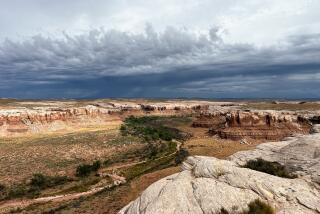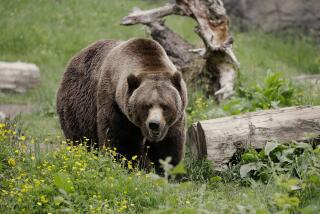Good News May Mean Bad News for Bears
- Share via
SPOKANE, Wash. — Grizzly bears may be among the most fearsome predators on Earth, but they won’t survive without Uncle Sam’s continued protection, advocates for the threatened species contend.
Despite denials from the federal government, some environmental groups are convinced that the Bush administration wants to knock grizzlies off the endangered species list.
That would allow development on some of the 6 million acres of protected habitat, which the groups say could crowd the bears out of existence.
“Delisting is obviously a way to get unhinged from federal protection a considerable amount of land,” said Louisa Willcox of the Natural Resources Defense Council. “Bears need big open spaces They need more country than they are in now.”
“Protecting bears stands in the way of a lot of economic development,” said bear researcher Steve Stringham of Soldotna, Alaska.
But Chris Servheen, the federal government’s coordinator for grizzly bear recovery for 22 years, said he is under no political pressure to delist the bears.
Interior Secretary Gale A. Norton has said she is committed to expanding bear populations in Yellowstone and Glacier national parks, where most of the estimated 1,100 grizzlies in the Lower 48 live now.
Servheen said grizzly numbers appear to be rising. In 2002, a record 52 females with cubs were reported. That was 10 more than the year before.
It is just such statements from grizzly managers that worry environmental groups.
Willcox recently released 17 pages of comments from various government officials and agencies over the past few years that she believes show that the government wants to delist grizzlies.
Servheen, who works for the U.S. Fish and Wildlife Service in Missoula, Mont., notes that the point of the endangered species program is to rebuild populations to the point where those species do not need protection.
Grizzlies are recovering, but the government is more than a year away from any effort to delist them, which would require a formal proposal released for public hearings, he said.
“What we are seeing is more bears and more cubs born, and bears occupying many habitats they have not been in for decades,” Servheen said. “They are far outside the Yellowstone recovery zone, where grizzlies have not been for 50 or 60 years.”
As late as the 1850s, more than 100,000 grizzlies lived in the western United States.
Because they preyed on humans and livestock, the bears were hunted nearly to extinction in the Lower 48 states. Today, the surviving grizzlies live around Yellowstone and Glacier national parks, the Idaho Panhandle and perhaps remote ranges in Washington state. Grizzlies continue to thrive in Alaska and British Columbia.
In 1975, they were listed as threatened under the Endangered Species Act.
Servheen and his critics agree on at least one thing: Preserving habitat is crucial to increasing the number of bears.
Willcox, who lives in Bozeman, Mont., said the federal government appeared to be moving toward ceding control of bear recovery to the states of Idaho, Montana and Wyoming. She worried that business interests that want to free up large chunks of land for development hold more power at the state level.
Opponents also worry that placing grizzlies under state control could potentially open the bears to hunting.
“Millions are poured into census methods to find out how many bears we’ve got, as if a magic number of bears makes it recovered,” Stringham said. But the federal government ignores the more important and complicated habitat issues crucial for long-term survival, he said.
Willcox said environmental groups also fear government researchers will try to link recovering populations in the Glacier National Park area with those believed in the Selkirk and Cabinet mountains of Idaho, Montana and Washington. The Glacier population could be delisted on grounds that, with 400 to 500 bears, it is recovered, and that would cover the Selkirks and Cabinets too, she warned.
More to Read
Sign up for Essential California
The most important California stories and recommendations in your inbox every morning.
You may occasionally receive promotional content from the Los Angeles Times.










